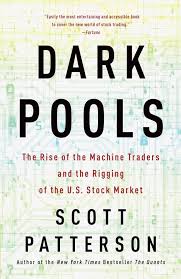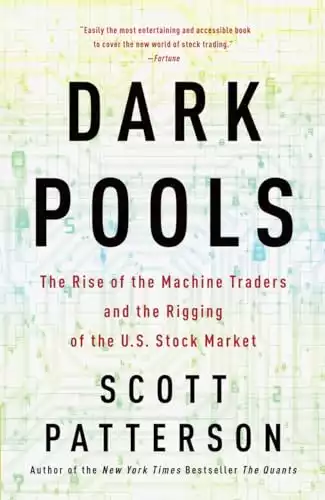Overview : Dark Pools
- Book Title: Dark Pools
- Author: Scott Patterson
- Publication Date: 12 June 2012
- price: $14.99
- Pages: 362
Overview of the Book
Scott Patterson is an American financial journalist and bestselling author. He serves as a staff reporter for The Wall Street Journal, covering topics such as hedge funds, high-speed trading, and financial regulation. His book "Dark Pools: High-Speed Traders, A.I. Bandits, and the Threat to the Global Financial System" delves into the rise of automated trading systems and their impact on financial markets.
Introduction
In the ever-evolving landscape of financial markets, Scott Patterson's "Dark Pools" emerges as a pivotal work, shedding light on the clandestine world of high-frequency trading (HFT) and its profound impact on Wall Street. This comprehensive review delves into Patterson's exploration of artificial intelligence in trading, market trends, and the ethical implications of technological advancements in finance.
Book Summary
Patterson's narrative skillfully weaves through the history of electronic trading, from its nascent stages in the late 1990s to the sophisticated AI-driven systems dominating today's markets. The author introduces readers to key figures who revolutionized trading, such as Josh Levine and Thomas Peterffy, providing an insider's perspective on the technological evolution that has reshaped investing and personal finance.
"The machines were on the rise, and they were winning."
This quote encapsulates the book's central theme: the relentless ascent of algorithmic trading and its far-reaching consequences for traditional market structures.
The Rise of High-Frequency Trading
Patterson meticulously details the development of HFT, explaining how algorithms execute thousands of trades per second, capitalizing on minute price discrepancies. This section is particularly enlightening for investors seeking to understand current market dynamics and trends.
Dark Pools and Market Structure
The author delves into the concept of "dark pools" - private exchanges for trading securities where speed and secrecy reign supreme. This exploration is crucial for comprehending modern market structures and the challenges they pose to regulators and traditional investors alike.
Analysis of Themes
The Quest for Speed
One of the book's central themes is the relentless pursuit of speed in trading. Patterson vividly describes the fierce competition among firms to gain even microsecond advantages, a race that has led to practices like colocation - placing servers as close as possible to exchange data centers.
Ethical Implications
Patterson raises critical questions about the fairness of a system dominated by sophisticated algorithms accessible only to the wealthiest firms. This discussion is particularly relevant in the context of personal finance and investing, as it highlights the growing divide between institutional and retail investors.
Regulatory Challenges
The book offers a candid critique of regulatory bodies struggling to keep pace with rapid technological advancements. This analysis is crucial for understanding the current state of financial regulation and its implications for market stability.
Writing Style
Patterson's writing strikes a balance between technical detail and narrative engagement. While the book occasionally delves into complex financial concepts, the author's storytelling prowess makes these ideas accessible to a broader audience, including those new to finance and technology.
Strengths and Weaknesses
Strengths:
- Comprehensive historical context of electronic trading
- Engaging profiles of key industry figures
- Clear explanation of complex technological concepts
- Thought-provoking analysis of ethical implications
Weaknesses:
- Occasional use of technical jargon may challenge some readers
- Limited exploration of potential solutions to the issues raised
Comparison to Other Works
"Dark Pools" stands out in the financial literature landscape for its focus on the technological aspects of modern trading. While Michael Lewis's "Flash Boys" covers similar ground, Patterson's work offers a more in-depth historical perspective and technical analysis. For readers interested in the intersection of technology and finance, "Dark Pools" provides a more comprehensive examination than general market analysis books like Burton Malkiel's "A Random Walk Down Wall Street.
Highlights from Dark Pools
- Dark pools: Explains private trading platforms used by institutional investors to buy and sell securities without public visibility.
- Market fragmentation: Highlights how dark pools contribute to fragmented financial markets.
- High-frequency trading: Examines the role of HFT firms in dark pool operations.
- Market manipulation: Discusses concerns about price manipulation and lack of transparency in dark pools.
- Regulation challenges: Explores the difficulties regulators face in overseeing dark pool trading.
- Impact on retail investors: Analyzes how dark pools affect market fairness for individual investors.
Conclusion
Scott Patterson's "Dark Pools" is an essential read for anyone seeking to understand the technological revolution reshaping financial markets. The book offers valuable insights for investors, finance professionals, and policymakers alike, shedding light on the hidden forces driving modern trading.
As we navigate an increasingly AI-driven financial landscape, Patterson's work serves as both a warning and a call to action. It challenges readers to consider the ethical and practical implications of a market where machines dominate, urging a reevaluation of what constitutes fair and efficient trading in the 21st century.
For those looking to deepen their understanding of market trends, investing strategies, and the future of finance, "Dark Pools" is an indispensable resource. Its revelations about the inner workings of Wall Street will undoubtedly influence how readers approach personal finance and investment decisions in an age of algorithmic trading.





